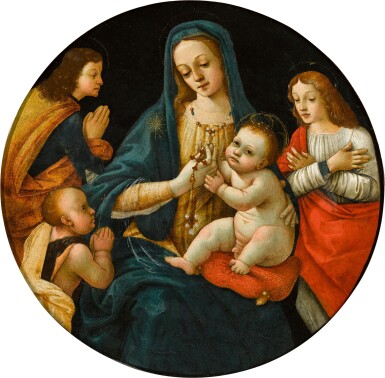The Dealer's Eye | London
The Dealer's Eye | London

Property from Benappi Fine Art, London
MICHELANGELO DI PIETRO MEMBRINI, FORMERLY KNOWN AS THE MASTER OF THE LATHROP TONDO | MADONNA AND CHILD, WITH THE INFANT SAINT JOHN AND TWO SAINTS
Lot Closed
June 25, 01:10 PM GMT
Estimate
40,000 - 60,000 GBP
Lot Details
Description
Property from Benappi Fine Art, London
MICHELANGELO DI PIETRO MEMBRINI, FORMERLY KNOWN AS THE MASTER OF THE LATHROP TONDO
Lucca, active 1484 - 1525
MADONNA AND CHILD, WITH THE INFANT SAINT JOHN AND TWO SAINTS
oil on panel, a tondo
unframed diameter: 40.9 cm.; 16 in.
framed diameter: 66 cm.; 26 in.
To view Shipping Calculator, please click here
Private collection, Norway;
Whence sold, London, Sotheby's, 4 December 2014, lot 127 (as circle of Lorenzo di Credi, with incorrect dimensions), where acquired.
"Few objects are as inextricably linked to the Tuscan Renaissance as tondo panels. This one was painted in Lucca, the charming and fiercely independent Tuscan town which for so long held off the martial advances of its neighbours. By this stage in the High Renaissance, tondi were often painted as aesthetic objects to be enjoyed, as well as for more traditional, devotional purposes, so it comes as no surprise that Membrini has spared little effort in the depiction of the bejewelled crucifix which hangs from the Madonna's neck."
Edoardo Roberti
Amongst all the painters in Lucca active at the turn of the sixteenth century, Michelangelo di Pietro, formerly known as the Master of the Lathrop Tondo, was the artist most influenced by Filippino Lippi. As this tondo demonstrates, the flesh tones and the intensity of expression are entirely informed by Filippino's idiom, particularly the wings at the Norton Simon Foundation, originally from the Bernardi altarpiece formerly in Santa Maria del Corso in Lucca, executed 1482–83.1 Direct comparisons with other works by Membrini confirm the attribution of the present work: similar chubby hands and eyelids, as well as comparable folds in the drapery, are to be found in the artist's Assumption of the Virgin from 1499 in the Ringling Museum, Sarasota, which was also most likely in the aforementioned church of Santa Maria del Corso in Lucca, and is unmistakably Filippinesque in character. The Virgin's necklace, made of pearls and gems, and her translucent veil, recall the Annunciation in the Santissima Annunziata outside Lucca and the altarpiece in San Cristoforo a Lammari in Capannori near Lucca.
Translated from a text by Professor Andrea De Marchi.
1 P. Zambrano and J. Katz Nelson, Filippino Lippi, Milan 2004, pp. 338–40, no. 26, reproduced.
